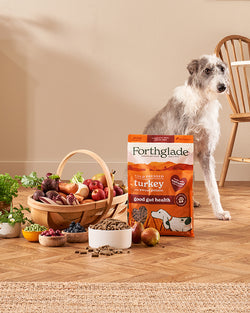Daily dog walks are not only a wonderful way to get some exercise alongside our canine companions, but important for growing our bond with them. However, when you have the time - taking longer, more exciting hikes in beautiful locations can be even more beneficial for enjoying wonderful experiences together, as well as an even better workout! To ensure you make the most of your adventures, we teamed up with Canine Behaviourist Caroline Wilkinson, to help prepare for all your hiking needs.

Be hiking ready!
Although most dogs appear to have endless energy, it’s important to make sure they are ready both in age (from about one year plus to ensure bone development is settled) and also with general fitness - as it is not just you that may require building up endurance levels before a substantial hike. Start slow and gradually build up both the length of hikes and the difficulty levels.
Keeping Fuelled up
If you’re planning a whole day trip for both yourself and your dog, then top of the list should be food and water added to your rusksack. A water bottle with a lid that acts as a bowl for your dog can save on space and if you can pick a route where you’ll be able to top up your water bottles that will really help - as water can be heavy to carry.
If you need to feed your dog a complete meal while you’re out, plan a good spot on your route to enjoy a decent break. Try to avoid exercising dogs on a full tummy; allow them at least 30 minutes after eating before you set off again. Alternatively, you can feed pieces of their meal throughout your walk as rewards for sticking with you. This will mean they’re not eating a whole serving in one go but they get the energy they need.
Remember that dogs can’t keep moving for as long as us - although they might not show it! They need double the amount of sleep as us humans, so if you’re planning a day-long hike, schedule a snooze session.

@National Trust Images - Christopher Heaney
Hiking with confidence
If you’re exploring somewhere new, especially if the terrain is slightly tricky to navigate or there’s unlikely to be any phone reception - make sure you let someone know your planned route. You can even use a GPS app to allow people to track you as you complete your hike. If you’re staying in a new location, save the number of a local emergency vet just in case you get into any trouble - you’re unlikely to need it, but better safe than sorry. It’s also always worth having a dog (and human) first aid kit packed on long walks.
When planning your route, check out if there’s any areas that restrict dog access or perhaps require them to be on-lead due to wildlife such as livestock or deer. Teaching your dog to walk calmly near you not only helps with the on-lead parts of your walks, but also if your dog is off-lead for narrow path sections. It can mean your dog is happy walking next to - or behind - you, instead of running back and forth risking sending you (or other walkers) flying.
If your dog isn’t comfortable in the presence of other dogs and people, walking in a busy location for a long time could be really stressful for them. Try to plan your hike in quieter spaces or where your dog can have a lot of space around them.
If a remote beauty spot is your hiking destination, you’re more likely to meet wildlife. Does your dog get distracted by squirrels, like to chase sheep, or would they put their nose down and run off if they discovered a deer track? If so, it's 100% worth investing in a long training lead. This allows your dog the freedom to explore safely while you have hold of them. They’re also great for dogs who generally have poor recall or display reactive behaviours.
Your dog may be micro-chipped but don’t forget to add a tag to their collar or harness. Name, address and mobile phone number is useful just in case you ever get separated.

@National Trust Images - John Malley
Waste management!
Don’t forget to pack waste bags so that the environment is always perfect for the next hiker. Double bagging and carrying on the exterior of a rucksack helps avoid any unpleasant aromas until you reach a bin.
Practicalities aside, hiking in a new area can be an incredible experience for us all. Your dog can enjoy the new surroundings and, more importantly, smells! And you can hopefully take the opportunity to switch off from day-to-day life. Leaving ‘to-do lists’ behind, let your dog show you how to be present in each moment. Stop and look at the things they sniff… when they pause to rest - take deep, slow breaths… and take a moment to focus on any unique sights - large landscapes, tall buildings, unique plant life. Being present in the moment and experiencing moments of feeling ‘awe’ on our walks can hugely boost mental wellbeing. A hike isn’t just a physical workout, it’s a tonic for your mental health as well.
So, where will your adventures take you this summer?
6 favourite hikes to enjoy with your dog:
Morte Point Walk, South West Coast Path
The South West Coast Path offers a wonderful variety of coastlines to hike with your four-legged friend, in fact there is over 630 miles of path to explore! North Devon offers stunning cliffs and paths, and a favourite is the Morte Point Walk, which covers a distance of 4.6 miles. Pass through an area of rare coastal heathland, where you can see many different sea birds and wildflowers, and even if lucky spot seals or dolphins. The deadly ‘Devil’s Teeth’ rocks along the spine of Morte Point continue underwater and have been responsible for many shipwrecks over the centuries. The walk also passes a beach and pubs where dogs are welcome.
Northumberland's natural beauty
More beautiful coastal scenery can be found along the Northumberland Coast, renowned for its breath-taking beaches, peaceful towns and rural splendour - making it an ideal location for dog lovers and hikers alike. From the stunning scenery and iconic castles you’ll find around Bamburgh and Holy Island to one of the UK’s most popular waterfalls at High Force, the area is packed with fantastic places to explore with your dog. The surrounding small towns nestled in Northumberland, also mean there are plenty of dog-friendly places to stay too, ready for a second day of adventures!
The lovely Lakes
The Lake District is a natural haven for hikers, offering challenging climbs to the top of some of the tallest mountains in the UK. For those with dogs, the area is rich in dog friendly pubs and picturesque walks. The Rawnsley Trail is one of our favourites for a warm-up walk, with the stunning view at Friar’s Crag, found along the way, described as “one of the best three or four views in the whole of Europe” by the National Trust’s co-founder, Hardwicke Drummond Rawnsley.
For those looking for something a little more challenging, the steeper ascent at Dodd Wood, near Bassenthwaite, is a hidden gem waiting to be discovered. With breath-taking views of both Derwent Water and Dumfries and Galloway, you’ll want your camera to hand to snap some shots of the incredible sights.
Combining the beauty of the great outdoors with an adventure for both you and your dog is the perfect way to explore the best of Britain this summer, and with our guide to some of the UK’s best hiking routes, you’ll be spoilt for choice when the Sun comes out.
Lorna Doone Valley, Devon
The well-known 'Doone village' is often described as a mystical place and makes for a lovely walk leading into a good hike. Start through picturesque countryside, cross moorland and meandering rivers that journey through gently rounded hills and woods – the variety will ensure a great adventure for all and probably a special lunch and a good night’s sleep! A perfect way to get lost in the peace of nature.
Roseberry Topping, North Yorkshire Moors National Park
A joy for dogs and a photographer’s paradise, Roseberry Topping takes over 1 mile of woodland and greenery in North Yorkshire. Filled with history and adventure Roseberry is the perfect location for dogs who need to burn off energy. Whilst not the steepest hill to tackle at 320 metres, the hill provides a great climb for walkers of all levels and offers spectacular views over the whole area. At summit you can breathe in the incredible views across the northern moors via the 360 degree panoramic viewpoint.
Alderley Edge Woodland Walk, Cheshire
For woddlands and waterfalls, this five mile walk which should take around 4 hours is set amongst dramatic sandstone escarpment and also offers woodland and waterfalls. It is a great spot of archaeological significance and is one of the National Trust’s most popular North West dog hiking routes. Check out the stunning views from Stormy Point.
Hiking is just one of many adventures that you can do with your four-legged friend. Get inspiration from our bucket list for you next adventure here


















 Over 8,481 5* Reviews
Over 8,481 5* Reviews
 Subscribe for 10% Off Every Order
Subscribe for 10% Off Every Order































